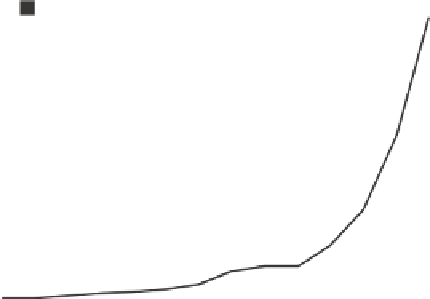Agriculture Reference
In-Depth Information
Scientific understanding of the determinants of fire regimes is far from com-
plete. Gill
et al.
(
2002
) have provided a very useful conceptual framework. They
note that large fires, though small in number, account for most of the area burned
and therefore the fire regime. Large fires occur when there is a high degree of
connectivity of fuel at a landscape scale (Gill
et al.
2002
). Key factors that affect
fuel connectivity are landscape features that act as fuel breaks, sufficiently con-
tinuous vegetation cover to support fire, and the coincidence of drought and
extreme weather conditions that enhance flammability. Gill
et al.
(
2002
) argue
that fire regimes are strongly structured by fires that coincide with high connect-
ivity events. The frequency of such events, together with the coincidence of
ignitions that ignite the fire, will determine the frequency of large fires. Their
frequency, in turn, will be a major determinant of the mix of plant functional types
that can occur in a fire-prone landscape.
These concepts are useful for analyzing determinants of fynbos fire regimes and
why they differ so strikingly from C
4
grassy ecosystems. The continuity of plant
cover as fuel varies with productivity and the growth form mix. Rainfall is a major
determinant of productivity in both shrublands and grasslands. Most studies of
fynbos as fuel have been in mesic fynbos with > 1000mm precipitation, which
equates with mesic C
4
grassland and savanna (> 750mm). The discussion that
follows refers to mesic fynbos and grasslands. Kruger (
1977
) recorded biomass
accumulation in fynbos of
2.5Mg ha
1
(ranging from 1 to 4 Mg ha
1
) for the
first 2-3 yrs after a fire but growth rates decline rapidly after that. Fynbos stands
< 7 yrs are often effective in stopping fires burning in older stands (
Fig. 7.9
).
∼
120
25
1981-1990
1991-2002
Burn-out age
100
20
80
15
60
10
40
5
20
0
0
Fynbos age class (yr)
Fig. 7.9
Effect of postfire age on cumulative area burned (%), and the frequency of ages against
which fires stopped burning (burn-out age, squares), Swartberg, Southern Cape. A natural
burning policy was in place from 1986 to 2002. (Based on data from Seydack
et al.
2007
.)







































